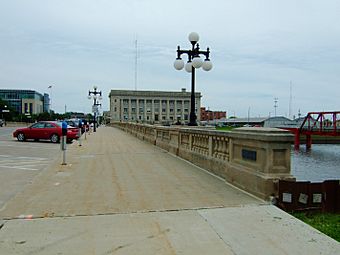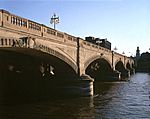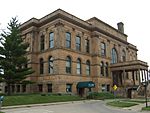Civic Center Historic District (Des Moines, Iowa) facts for kids
Quick facts for kids |
|
|
Civic Center Historic District
|
|

The Court Avenue Bridge with the Municipal Court Building to the right.
|
|
| Location | Both banks of the Des Moines River from the Center St. Dam to the Scott Ave. Dam Des Moines, Iowa |
|---|---|
| Area | 93 acres (38 ha) |
| Architectural style | Art Deco, Beaux-Arts |
| MPS | The City Beautiful Movement and City Planning in Des Moines, Iowa 1892—1938 MPS |
| NRHP reference No. | 88001168 |
| Added to NRHP | December 7, 1988 |
The Civic Center Historic District is a special area in downtown Des Moines, Iowa, United States. It's located along the Des Moines and Raccoon Rivers, right where they meet. This district is important because it shows how cities were planned a long time ago. It has been listed on the National Register of Historic Places since 1988, meaning it's recognized for its historical value.
Contents
Exploring the Historic Civic Center
The buildings and structures in this district were mostly built between 1900 and 1938. These are called "contributing properties" because they help tell the story of the district's history.
There are six main public buildings here:
- The Armory and World War Memorial Building
- The old Public Library of Des Moines
- The old Post Office
- Des Moines City Hall
- The Municipal Court Building
- The U.S. Court House
And seven important structures:
- The Center Street Dam
- West River Front Park
- East River Front Park
- The River Walls
- The Scott Avenue Bridge and Dam
- The Court Avenue Bridge
- The Riverside Drive Bridge
Some other bridges, like the Grand Avenue Bridge, were changed a lot over time. Because their original look was removed, they no longer contribute to the district's historic feel.
Planning the City Beautiful
The buildings in the Civic Center district were built along the river. This was part of a big plan to develop the riverfront. Both the East and West Riverfront Parks are great examples of the City Beautiful Movement. This movement aimed to make cities more beautiful and organized.
The main fronts of the city government buildings face the river. Federal government buildings, however, face the street. Part of the planning also included preventing floods from the rivers. The Raccoon River often flooded where it met the Des Moines River.
To stop floods, over 11,617 feet of river walls were built. These walls also include a sewer system to handle storm water. Plans for these walls were finished in 1908. However, the walls were not fully built until 1938. This work was done as projects of the Civil Works Administration and the Works Project Administration. These were government programs that created jobs during tough economic times.
Architectural Styles and Features
Most of the buildings in the Civic Center Historic District were built between 1900 and 1928. These include the library, post office, municipal building, municipal court building, and U.S. Courthouse. All of them are designed in the Beaux-Arts style.
Beaux-Arts Design
Beaux-Arts is a grand and formal architectural style. Buildings in this style often use stone, large columns, and decorative railings called balustrades. They also feature simple cornices (decorative tops) and round-arched openings.
The City Beautiful movement wanted buildings to blend together. The goal was for them to work as a unit, not stand out on their own. The inspiration for this district came from several places. These included the "White City" at Chicago's 1899 Columbian Exposition. Ideas also came from the École des Beaux-Arts in Paris and European city designs. Even though the Armory building is in the Art Deco style, it still fits well with the other buildings.
River Walls and Bridges
The river walls were designed to be both pretty and useful. They are made of concrete and feature the same balustrade design seen on the public buildings and bridges. The Court Avenue Bridge also uses balustrades and rounded arches, just like the buildings.
The Scott Avenue Bridge over the Des Moines River and the Riverside Bridge over the Raccoon River are both concrete arch bridges. They are located near where the two rivers meet. Both bridges were finished in 1937 and were funded by the Works Progress Administration.
The Scott Avenue Bridge also has a dam next to it. This concrete dam was built at the same time as the bridge. It helps control the water flow. The Center Street Dam anchors the northern end of the historic district. It is also the end point for the river walls. This dam was built in 1917 and is a concrete multiple-arch dam.
Gallery of Contributing Properties







